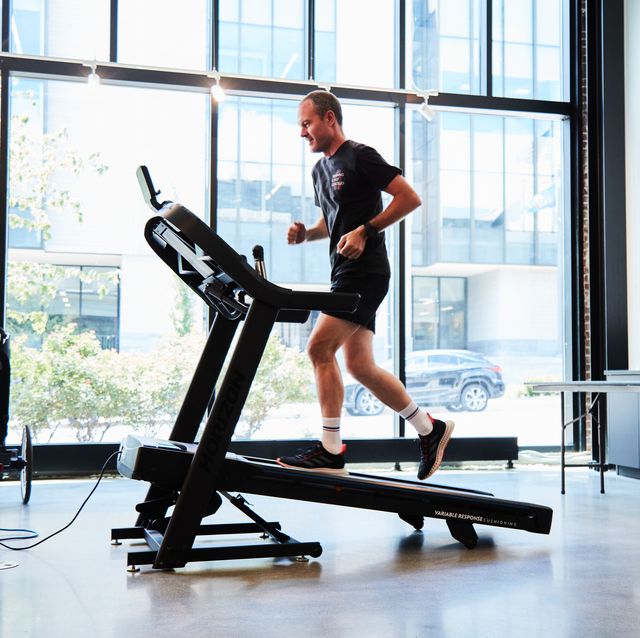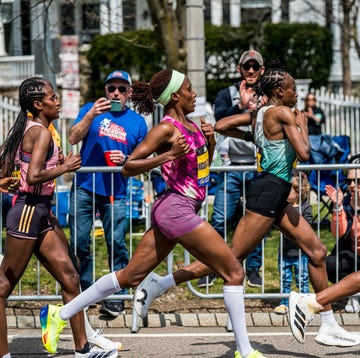It’s a common running dilemma: you’ve signed up for a hilly race, or simply want to add long hill repeats to your weekly schedule, but your local area is as flat as a Dutch motorway.
What can you do? Take the car or train to your nearest set of hills? Up sticks to the Lake District? Pretend that tiny incline constitutes a hill? No – you jump on the treadmill.
When it comes to recreating hilly terrain, the ’mill is a seriously useful bit of kit. Set the angle and duration to your requirements, and suddenly you have yourself a fuss-free, traffic-free hill session.
What everyone's reading
While many coaches often discourage doing too much training on the treadmill (a controlled environment may not prepare you enough for whatever weather gets thrown your way on race day), hill workouts provide the perfect way to make the treadmill work in your favour.
Also, the benefits of hill running include recruiting more muscle fibres from the glutes, hamstrings, quads, and calves, all of which have to produce more power to move you uphill, says Athena Farias, a running coach, personal trainer and five-time Boston Marathon qualifier based in the US state of Texas. It also requires a more upright posture and a shorter stride length than running on a flat surface, which can help reduce that impact, she adds.
To gain these advantages and help you nail your hilly race, we got coach-recommended strategies to efficiently tackle hill training on the treadmill, as well as specific treadmill incline workouts to incorporate into your marathon build-up.
4 tips for hill training
1. Zero in on downhills
Downhills are often what cost many people their races. To train your quads to stay happy through the end of the race, focus on running controlled and consciously – not bombing downhill in your training.
Some treadmills, such as those by NordicTrack and Technogym, have a decline capability that allows them to go down to -2 or -3%. If yours doesn’t, Farias says that 0% is the next best thing. (Experts typically recommend that you set a treadmill at 1% to simulate any changes in terrain that you’d experience on an outdoor run.)
2. Ease into hill training
Whether you’re running outdoors or on a treadmill, start with easy runs on a hilly route before jumping into intervals, if you’re not used to running on an incline. As noted by California-based running coach Natalie Mitchell, this is especially important on a treadmill – if you go too hard on a treadmill too soon, you’ll not only feel gassed out, but also increase your chance of getting injured because your form might be slightly off at the start.
‘When you are running downhill, relax the body, avoid leaning backward and [focus on landing] on the forefoot, not the heel’ she says. ‘You’ll benefit more from running by feel, instead of staring at your watch, and spending your energy focusing on proper form.’
Also, avoid trying to sprint up hills in most of your training and instead focus on an even effort. ‘[That means] whatever your effort is on the flat, that effort should be the same when you’re going uphill and then really controlled on the downhill, where you can speed up just a little bit,’ says Farias.
‘I am a big believer that hill training is speed training in disguise,’ she adds. ‘It just gives you another level of intensity without having to push your body or focus so much on pace.’
3. Understand that you’ll go slower
Even though treadmill running entails running in a controlled environment, many runners find that they have to slow down their default paces just to feel more in control when gauging effort, especially on hill intervals. Farias and Mitchell both agree that this is fine and not at all detrimental to training.
In fact, Farias often has athletes do longer downhill repeats of about 800 meters to 1 mile about 10 to 20 seconds slower than their goal marathon pace to help them reel in the tendency to want to start out too fast.
‘Short- to medium-distance hill sprints (10 to 30 seconds in duration) at a hard effort (about 7 to 9 on the rate of perceived exertion scale), but not all-out, are also an excellent way to get in a good workout and I would say that you get more bang for the buck with hill sprints than running easy all the time on hills,’ says Mitchell. ‘Patience is key. You will naturally get faster the more hill work you do over time.’
4. Be specific with the gradient
It’s a common myth to think that your hill of choice needs to be precipitously steep. In fact, a shallow gradient (less than 10%) will work better for lots of runners as it allows you to maintain a decent amount of speed. Steeper gradients can be useful for specific types of workouts like 6-8 seconds of all-out effort with three-minute recoveries. For more classic sessions, such as 8 x 1-minute hard uphill, shallower gradients are absolutely fine.
6 treadmill incline workouts to prepare for hills
If you’re training a hilly race, or want to feel more capable on undulating terrain, try to build the following treadmill workouts into your training regime. Mitchell recommends supplementing the first three workouts on this list with an easy 1- to 2-mile warm-up and cooldown at a 0% incline.
1. 10-second sprints
Short hill sprints are an excellent way to get the legs moving fast and efficiently on hills, says Mitchell. Focus on good form (short, quick steps with high knees) on each rep and take time to jog slowly as a recovery to prepare for the next one.
‘I recommend running the short sprints at the end of a medium run (five to eight miles depending on the experience of the runner), so that you are running on fatigued legs, which will help prepare you for rolling hills,’ notes Mitchell.
- 6-8 x 10-second hill sprints at an 8% to 10% incline (11% to 14% for more advanced runners) at slightly faster than marathon pace
- Easy 1-minute jog between each rep
2. 30-second sprints
‘Some runners may find the pace [of these hill repeats] is equivalent to marathon pace, but it should feel faster than that,’ says Mitchell. ‘Run by feel (staying around 7 to 9 on the RPE scale, a.k.a. hard to extremely hard, but not maximum effort) and be patient – 30 seconds is a long time on a hill, and you want to feel recovered before the next repeat.’
- 6 x 30-second hill repeats at an 8% to 10% incline at a hard effort (slightly faster than marathon pace)
- Easy 90-second jog between each rep
3. Long run incline build
‘Physically, you should also plan for long runs that have hills in the middle of them and you can absolutely get creative with this if you live in a pancake-flat area,’ says Mitchell. ‘One idea is to run the first half of your long run outside and then the second half on the treadmill.’
- In the middle (starting around mile 4) of an 8-mile run, add in a long, gradual hill by increasing the treadmill incline to 4% or 5% for 60 to 90 seconds
- Bring the incline back to 0% to run moderately for 5 minutes
- Repeat 3-4 times
4. Incline and decline workout
Farias recommends the following workout in the first two to four weeks of a 16-week training cycle, focusing on shorter blocks of uphill and downhill repeats. This will get you to tackle both the ascents and descents along the course.
- 1- to 2-mile warmup at a 2% incline
- 4-6 x 30 seconds at marathon pace, 4% incline
- 60-seconds at recovery pace between reps, -1 to -2% decline
- 1- to 2-mile cooldown, 0% to -2% decline
Once you get two to eight weeks into your hill-specific training, Farias recommends turning up the challenge:
- 1- to 2-mile warmup at a 2% incline
- 6-8 x 60-90 seconds at marathon pace, 4% to 6% incline
- 90-seconds to 3 minutes at recovery pace between reps, -3% to -5% decline
- 1- to 2-mile cooldown, 0% to -2% decline
5. Tempo hill session
Looking to add a bit of variety (read: additional trauma) to your hill session? Add in a tempo run. Here’s how:
- 1- to 2-mile warm-up
- 6 x 30 seconds uphill, with 90 seconds walk-down recovery between reps
- Straight into a 6-minute tempo run
- 6 x 30 seconds uphill, with 90 seconds walk-down recovery between reps
- Straight into a 6-minute tempo run
- 1- to 2-mile cooldown
6. Downhill repeats
‘Running downhill allows you to pick up speed without increasing your effort level,’ says Farias. ‘It’s also pure specificity of training for Boston since the first six miles of the race are downhill. By including downhill repeats you are strengthening your muscles, ligaments, tendons, and bones, [as well as] developing mental toughness, as it requires focus and concentration to maintain your balance and control your speed.’
Here is Farias’ go-to downhill workout:
- 5 x 1-mile downhill repeats at a -3% to -5% decline (or 0% if your treadmill doesn’t have this capability) at anywhere between your 5K and 8km pace
- 90 seconds rest between















